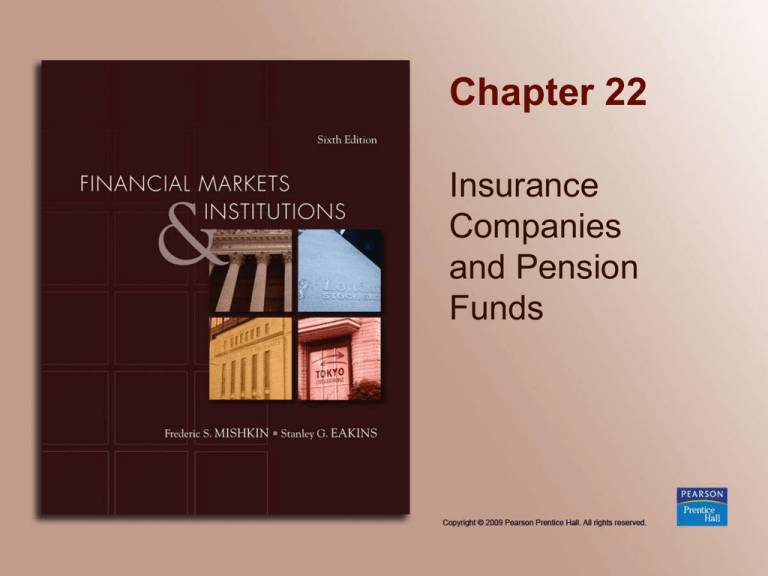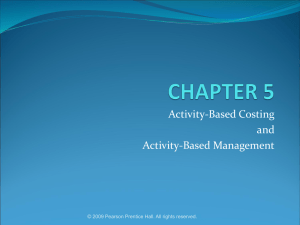
Chapter 22
Insurance
Companies
and Pension
Funds
Chapter Preview
• We look at two nonbank institutions: insurance
companies and pension funds. We view them in
a similar light as other financial intermediaries
because they take funds from one sector and
invest them in another. Topics include:
– Insurance Companies
– Fundamentals of Insurance
– Growth and Organization of Insurance Companies
– Types of Insurance
Copyright © 2009 Pearson Prentice Hall. All rights reserved.
22-2
Chapter Preview
– Pensions
– Types of Pensions
– Regulation of Pension Plans
– The Future of Pension Funds
Copyright © 2009 Pearson Prentice Hall. All rights reserved.
22-3
Insurance Companies
• Insurance companies assume the risk of
their clients in return for a fee, called
the premium.
• Most people purchase insurance because
they are risk-averse—they would rather pay
a certainty equivalent (the premium) than
accept a gamble
Copyright © 2009 Pearson Prentice Hall. All rights reserved.
22-4
Insurance Companies:
Major Employer
Copyright © 2009 Pearson Prentice Hall. All rights reserved.
22-5
Fundamentals of Insurance
• Although there are many types of
insurance and insurance companies, there
are seven basic principles all insurance
companies are subject to:
1. There must be a relationship between the
insured and the beneficiary. Further, the
beneficiary must be someone who would
suffer if it weren’t for the insurance.
Copyright © 2009 Pearson Prentice Hall. All rights reserved.
22-6
Fundamentals of Insurance
2. The insured must provide full and accurate
information to the insurance company.
3. The insured is not to profit as a result of
insurance coverage.
4. If a third party compensates the insured for the
loss, the insurance company’s obligation is
reduced by the amount of the compensation.
Copyright © 2009 Pearson Prentice Hall. All rights reserved.
22-7
Fundamentals of Insurance
5. The insurance company must have a large
number of insured so that the risk can be spread
out among many different policies.
6. The loss must be quantifiable. For example, an
oil company could not buy a policy on an
unexplored oil field.
7. The insurance company must be able to
compute the probability of the loss’s occurring.
Copyright © 2009 Pearson Prentice Hall. All rights reserved.
22-8
Adverse Selection and Moral Hazard in
Insurance
As we have seen in previous chapters,
asymmetric information plays a large role in
the design of insurance products. As with
other industries, the presence of adverse
selection and moral hazard impacts the
industry, but is fairly well understood the
insurance companies.
Copyright © 2009 Pearson Prentice Hall. All rights reserved.
22-9
Adverse Selection in Insurance
The adverse selection problem raises the
issue of which policies an insurance
company should accept:
• Those most likely to suffer loss are most
likely to apply for insurance.
• In the extreme, insurance companies
should turn anyone who applies for an
insurance policy.
Copyright © 2009 Pearson Prentice Hall. All rights reserved.
22-10
Adverse Selection in Insurance
However, insurance companies have
found reasonable solutions to deal with
this problem:
• Health insurance policies require a
physical exam.
• Preexisting conditions may be excluded
from the policy.
Copyright © 2009 Pearson Prentice Hall. All rights reserved.
22-11
Moral Hazard in Insurance
Moral hazard occurs in the insurance
industry when the insured fails to take
proper precautions (or takes on more risk)
to avoid losses because losses are covered
by the insurance policy.
• Insurance companies use deductibles to
help control this problem.
Copyright © 2009 Pearson Prentice Hall. All rights reserved.
22-12
Fundamentals of Insurance
•
Another problem is that most people don’t
purchase enough insurance. Insurance
companies use a strong sales force to
combat this.
– Independent agents may sell the insurance products
of a number of different insurance companies.
– Exclusive agents only sell the products of
one company.
– An underwriter reviews each policy prior to its
acceptance to determine if the risk is acceptable.
Copyright © 2009 Pearson Prentice Hall. All rights reserved.
22-13
Growth and Organization
of Insurance Companies
• The number of insurance companies grew
steadily until 1988, and since then the
number has fallen steadily.
• This can be seen in the next slide.
Copyright © 2009 Pearson Prentice Hall. All rights reserved.
22-14
Growth and Organization
of Insurance Companies
Copyright © 2009 Pearson Prentice Hall. All rights reserved.
22-15
Growth and Organization
of Insurance Companies
• The previous slide also shows that insurance
companies may be organized in two
difference ways:
– A stock company is owned by shareholders and has
a profit motive
– A mutual insurance company is owned by the
policyholders and attempts to provide the lowest
cost insurance
• At the end of 2005, only 135 of 1119 insurance
companies were mutual insurance companies.
Copyright © 2009 Pearson Prentice Hall. All rights reserved.
22-16
Types of Insurance
Insurance is classified by which type of
undesirable event is covered:
• Life Insurance
• Health Insurance
• Property and Casualty Insurance
Copyright © 2009 Pearson Prentice Hall. All rights reserved.
22-17
Life Insurance
Life insurance policies come in many forms.
Some of the typical policies include:
• Term Life: the insured is covered while the policy
is in effect, usually 10–20 years.
• Whole Life: similar to term life, but allows the
policyholder to borrow against the policies cash
value. When the term of policy expires, the
insured can get the cash value of the policy.
Copyright © 2009 Pearson Prentice Hall. All rights reserved.
22-18
Life Insurance
Life insurance policies come in many
forms. Some of the typical policies include:
• Universal Life: includes both a term life
portion and a savings portion.
• Annuities: pays a benefit to the insured until
death, to cover retirement years.
Copyright © 2009 Pearson Prentice Hall. All rights reserved.
22-19
Expected Life of Persons
at Various Ages
Copyright © 2009 Pearson Prentice Hall. All rights reserved.
22-20
Sample Annual Premiums
Copyright © 2009 Pearson Prentice Hall. All rights reserved.
22-21
Life Insurance:
Company Assets and Liabilities
• Life insurance companies derive funds from
two sources:
– They receive premiums that must be used to
payout future claims when the insured dies
– They receive premiums paid into pension
funds managed by the life insurance company
• The next figures shows the distribution of
the typical life insurance company’s assets,
as well as assets invested in mortgages.
Copyright © 2009 Pearson Prentice Hall. All rights reserved.
22-22
Life Insurance:
Company Assets and Liabilities
Copyright © 2009 Pearson Prentice Hall. All rights reserved.
22-23
Life Insurance:
Company Assets and Liabilities
Copyright © 2009 Pearson Prentice Hall. All rights reserved.
22-24
Life Insurance:
Company Assets and Liabilities
• Life insurance companies have two
primary liabilities:
– Life insurance payouts
– Pension fund payouts
Copyright © 2009 Pearson Prentice Hall. All rights reserved.
22-25
Health Insurance
• Health insurance policies are highly
vulnerable to the adverse selection
problem. Those with known or expected
health problems are more likely to seek
coverage.
• This is why most health insurance is
offered through group policies. Individual
policies must be priced assuming adverse
selection.
Copyright © 2009 Pearson Prentice Hall. All rights reserved.
22-26
Health Insurance
Health insurance is a hot topic in the
political environment, focusing on
increased costs and availability
of coverage.
• Insurance programs are attempting to shift
costs to the employers.
• Health Maintenance Organizations are
another attempt to keep costs down.
Copyright © 2009 Pearson Prentice Hall. All rights reserved.
22-27
Property and Casualty Insurance
• Property Insurance: protects businesses and
owners from the risk associated with ownership.
– Named-peril policies: insures against any losses only
from perils specifically named in the policy
– Open-peril policies: insures against any losses except
from perils specifically named in the policy
• Casualty Insurance
• Reinsurance
Copyright © 2009 Pearson Prentice Hall. All rights reserved.
22-28
Property and Casualty Insurance
• Casualty Insurance: also known as liability
insurance, it protects against financial
losses because of a claim of negligence.
• Reinsurance: allocates a portion of the risk
to another company in exchange for a
portion of the premium.
Copyright © 2009 Pearson Prentice Hall. All rights reserved.
22-29
Insurance Regulation
• The McCarran-Ferguson Act of 1945
explicitly exempts insurance companies
from any type of federal regulation.
• Most insurance regulations is at the
state level
• Regulation is typically designed to protect
policyholders from losses, or expand
insurance coverage in the state.
Copyright © 2009 Pearson Prentice Hall. All rights reserved.
22-30
Conflict of Interest Violations
• In 2004, NY Attorney General E. Spitzer
charged Marsh and McLennan with
insurance fraud.
• Indictment cited bid-rigging and bribery.
Some of the pay-for-play fees amounted to
$800 million per year.
• Many top execs left the firm in the wake of
the incident.
Copyright © 2009 Pearson Prentice Hall. All rights reserved.
22-31
The Practicing Manager:
Insurance Management
• Screening
• Risk-Based Premium
• Restrictive Provisions
• Prevention of Fraud
• Cancellations of Insurance
• Deductibles
• Coinsurance
• Limits on the Amount of Insurance
Copyright © 2009 Pearson Prentice Hall. All rights reserved.
22-32
Pensions
• Definition: A pension plan is an asset pool that
accumulates over an individual’s working years
and is paid out during the nonworking years.
• Developed as Americans began relying less on
children for care during their later years.
• Also became popular as life
expectancy increased.
Copyright © 2009 Pearson Prentice Hall. All rights reserved.
22-33
Types of Pensions
• Defined-Benefit Pension Plans: a plan where the
sponsor promises the employee a specific benefit
when they retire.
• For example, Annual Retirement Payment =
2% average of final 3 years’ income years of service
Copyright © 2009 Pearson Prentice Hall. All rights reserved.
22-34
Types of Pensions
• Defined-Benefit Pension Plans place a
burden on the employer to properly fund
the expected retirement benefit payouts.
– Fully funded: sufficient funds are available to
meet payouts
– Overfunded: funds exceed the
expected payout
– Underfunded: funds are not expected to meet
the required benefit payouts
Copyright © 2009 Pearson Prentice Hall. All rights reserved.
22-35
Types of Pensions
• Defined-Contribution Pension Plan: a plan where
a set amount is invested for retirement, but the
benefit payout is uncertain.
• Private Pension Plans: any pension plan set up
by employers, groups, or individuals
• Public Pension Plan: any pension plan set up by
a government body for the general public (e.g.,
Social Security)
Copyright © 2009 Pearson Prentice Hall. All rights reserved.
22-36
Private Pension Plan Assets
Copyright © 2009 Pearson Prentice Hall. All rights reserved.
22-37
Social Security
• Pay as you go system, where current
funding is used (partially) to pay
current benefits.
• Projected number of workers is falling while
projected number of retirees is increasing,
which will cause problems in years to come
if not corrected.
Copyright © 2009 Pearson Prentice Hall. All rights reserved.
22-38
Social Security Assets
22-39
Social Security Assets
22-40
Social Security
• It’s difficult to measure the health of the
social security system. Many factors are
hard to predict, such as birth rates and the
rate of immigration. Although it may not
fail, it’d be wise for you plan other sources
for your retirement cash flows.
Copyright © 2009 Pearson Prentice Hall. All rights reserved.
22-41
Regulation of Pension Plans
A major U.S. Supreme Court decision in
1949 established that pension benefits
were a legitimate part of collective
bargaining. The number of plans increased
from this as unions negotiated for
such plans.
Copyright © 2009 Pearson Prentice Hall. All rights reserved.
22-42
Regulation of Pension Plans
• Employee Retirement Income Security Act
of 1974
– Established guidelines for funding
– Allowed plan credit to transfer with employees
– Established vesting requirements to gain
plan benefits
– Increased disclosure requirements
– Assigned regulatory oversight to the
Department of Labor
Copyright © 2009 Pearson Prentice Hall. All rights reserved.
22-43
Regulation of Pension Plans
• ERISA also established the Pension
Benefit Guarantee Corporation to insure
pension benefits if an underfunded pension
plan is unable to meet its obligations.
– Accounting makes it difficult to assess funding
status of a plan
– May be in trouble as plans appear
underfunded
Copyright © 2009 Pearson Prentice Hall. All rights reserved.
22-44
Regulation of Pension Plans
• The next slide shows the annual payments
made since 1980 to failed plan participants.
In 2005, the PBGC said that the plan has
never been under more stress…
Copyright © 2009 Pearson Prentice Hall. All rights reserved.
22-45
Participants and Beneficiaries Receiving
PBGC Payments
Copyright © 2009 Pearson Prentice Hall. All rights reserved.
22-46
Regulation of Pension Plans
• Pension Protection Act of 2006 was passed
to address the growing problem of failed
pension plans. The act provides for
stronger funding rules, greater
transparency, and a strong pension
insurance system.
Copyright © 2009 Pearson Prentice Hall. All rights reserved.
22-47
Regulation of Pension Plans
• Pension Reform Act of 1978 authorized
individual retirement accounts.
– Enjoy a preferential tax treatment
– Keogh plans are similar plans for selfemployed individuals
– SIMPLE IRAs are simplified retirement plans
for small businesses.
Copyright © 2009 Pearson Prentice Hall. All rights reserved.
22-48
The Future of Pension Funds
• We can expect their growth and popularity
as the average population continues
to grow.
• Variety of pension fund offerings may
increase as well.
• Pension funds may gain significant
control of corporations as their stock
holdings increase.
Copyright © 2009 Pearson Prentice Hall. All rights reserved.
22-49
Chapter Summary
• Insurance Companies: the nature of the
industry, including rationale and people
employed in the industry, was presented.
• Fundamentals of Insurance: the seven
fundamental ideas behind all insurance
were listed and reviewed.
Copyright © 2009 Pearson Prentice Hall. All rights reserved.
22-50
Chapter Summary (cont.)
• Growth and Organization of Insurance
Companies: the changes in growth patterns
over the last several decades was
reviewed, including both assets and
number
of companies.
• Types of Insurance: the variety of insurance
policies available covering life, health, etc.,
were presented.
Copyright © 2009 Pearson Prentice Hall. All rights reserved.
22-51
Chapter Summary (cont.)
• Pensions: the general idea and growth in
pension funds was presented.
• Types of Pensions: the various forms, from
defined-benefit to defined-contribution,
were reviewed and compared.
Copyright © 2009 Pearson Prentice Hall. All rights reserved.
22-52
Chapter Summary (cont.)
• Regulation of Pension Plans: ERISA and
other laws that govern pension funds
was discussed.
• The Future of Pension Funds: we should
expect their popularity, size, and power to
continue to grow as the population ages.
Copyright © 2009 Pearson Prentice Hall. All rights reserved.
22-53





